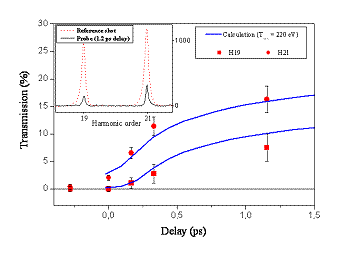
Temporal evolution of H19 and H21 through plasma created by irradiation at maximum intensity of 3x1017W/cm2, on 100nm polypropylene foil. Blue line: Numerical simulations. Inset: (dotted line) reference spectrum without plasma, (full line) sp ectrum recorded 1.2ps after the creation of the plasma
Temporal evolution of XUV transmission with 100fs resolution for characterizing plasmas created by intense irradiation of thin polypropylene foils.
The plasma is created by intense irradiation (I≈3x1017W/cm2) of thin polypropylene foils, on UHI10 laser facility (CEA-Saclay). The pedestal, which could damages the target before the arrival of the intense part of the laser pulse, has been reduced implementing plasma mirror on the laser system. The probe beam is a High order Harmonic Generated (HHG) in gas jet.
The method to characterize dense plasma is based on the critical density dependence on λ-2. The idea is to measure the transmission of several harmonics through the plasma, simultaneously. The ones for which the critical density exceeds the plasma electronic density will be transmitted whereas the ones for which Ncr is less than the plasma density will be stopped. The initial electronic density is then determined by the first harmonic transmitted, whereas the electronic temperature is extracted from comparison between numerical simulations and temporal evolution of the plasma.
Experimental results are shown on figure bellow. The temporal evolution of H19 and H21, respectively 42 and 38nm, through plasma created by intense irradiation of polypropylene is reported. The pump beam (60fs, 10Hz, 800nm) has been focused at I≈3x1017W/cm2. The inset corresponds to a reference spectrum without plasma (dotted line) and a spectrum 1.2ps after the creation of the plasma (full line).
The H19 and H21 zero transmission for Δt<0 means that the target is not destroyed before the plasma creation. For Δt=0, H21 is partially transmitted whereas H19 is still not. This is used to estimate Ne0, the initial electronic density of the plasma, close to 3.1x1023 cm-3±20%.
A 1-D hydrodynamic code is used to simulate the plasma evolution, considering Te0 as a variable parameter. The transmission of H19 and H21 is then calculated solving Helmoltz equation for both harmonics simultaneously. A good accord between experiment and numerical simulations for Te0=220±20eV.
In summary, recording simultaneously the transmission signal for several harmonics as a function of the temporal delay between the plasma creation and the XUV probe, with 100fs resolution, allowed for determining the initial electronic density, Ne0=3.1x1023 cm-3±20% and temperature, Te0=220±20eV parameters of the plasma created in our experimental conditions.
S. Dobosz, G. Doumy, H. Stabile, P. d'Oliveira, P. Monot, F. Réau, S. Hüller and Ph. Martin, Phys. Rev. Lett. (2005) 95 025001
• Service des Photons Atomes et Molécules
• Groupe édifices nanométriques • Laboratoire Francis Perrin • Matière sous conditions extrêmes • Matter under Extreme Conditions • Support et Lasers à Impulsions courtes / Support and short pulse lasers











